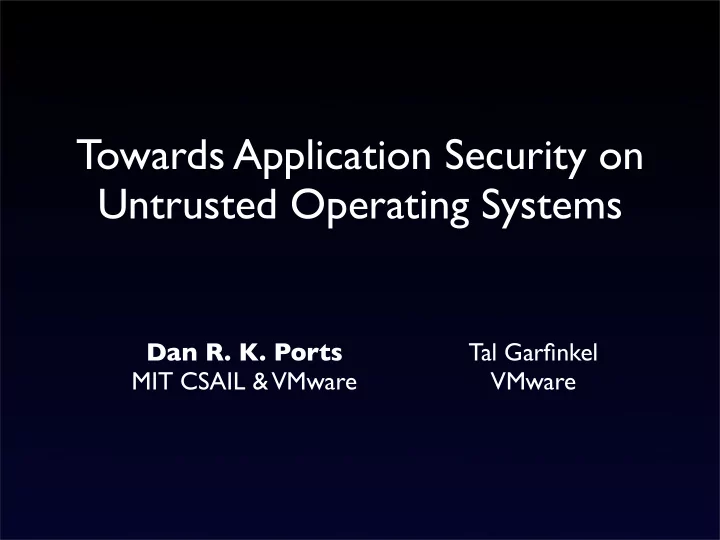

Towards Application Security on Untrusted Operating Systems Dan R. K. Ports Tal Garfinkel MIT CSAIL & VMware VMware
Motivation Many applications handle sensitive data financial, medical, insurance, military... credit cards, medical records, corporate IP... ...but run on commodity operating systems Complexity leads to poor assurance!
Large TCB Sizes Theory: Other App App few small trusted parts; App Apps can be assumed correct OS Hardware
Large TCB Sizes Theory: Other App App few small trusted parts; App Apps can be assumed correct Reality: OS has many trusted parts: OS - kernel - device drivers - system daemons - anything running as root Hardware
This is a problem.
This is a problem. (and it’s not likely to solve itself)
Defense in Depth Approach
Defense in Depth Approach Continue to use existing OS components, without fully trusting them Add security layer to protect sensitive data even if OS is compromised
Defense in Depth Approach Continue to use existing OS components, without fully trusting them Add security layer to protect sensitive data even if OS is compromised Desired security property: apps always behave normally even if the OS behaves maliciously
Defense in Depth Approach Continue to use existing OS components, without fully trusting them Add security layer to protect sensitive data even if OS is compromised Desired security property: apps always behave normally (or fail-stop) even if the OS behaves maliciously
Problem: OS solely responsible for CPU / memory resource management ➡ can access application memory & control application execution Solution: isolated execution environment ➡ give app memory that OS can’t access
Is CPU & memory isolation enough to run apps securely on an untrusted OS?
Is CPU & memory an untrusted OS? No! isolation enough to run apps securely on Apps still explicitly rely on OS services, so semantic-level attacks are possible.
Background: Isolation Architectures Other App App App Apps Legacy OS
Background: Isolation Architectures Isolation can be enforced via: Other App App Apps • microkernel processes ( e.g. Nizza / L4) Legacy OS Legacy OS App Trusted Services Microkernel
Background: Isolation Architectures Isolation can be enforced via: Other App App App Apps • microkernel processes ( e.g. Nizza / L4) • separate VMs Private Legacy OS Legacy OS ( e.g. Proxos, OS NGSCB) VMM
Background: Isolation Architectures Isolation can be enforced via: Other App App App Apps • microkernel processes ( e.g. Nizza / L4) • separate VMs Legacy OS Legacy OS ( e.g. Proxos, NGSCB) • encrypted application state Crypto ( e.g. XOM, processor / VMM Overshadow)
Isolation Properties • secrecy: resources can’t be read by the OS • integrity: resources can’t be modified (without being detected) • secure control transfer: OS can’t affect control flow, except via syscalls/signals No defense against semantic attacks!
Malicious OS Example Thread 1 Thread 2 acquire_lock(l); acquire_lock(l); isEncrypted = true; if (isEncrypted) { encrypt(data); sendToNet(data); release_lock(l); } release_lock(l); OS grants lock to both threads, introducing a new race condition!
More OS Misbehavior A malicious OS could: • read or modify file contents • even if encrypted, swap two files • snoop on keyboard/display I/O • change system clock (break time-based auth) • control /dev/random (break crypto) (more examples & solutions in paper)
Towards Application Security Ensure that system call results are valid (safety properties only; no availability) Three approaches: • verify correctness of system call results • emulate system call in trusted layer • disallow system call / “use at own risk”
Verifying Mutexes Create “lock-held?” flag in shared memory • update after lock acquired & before released • when acquiring lock, check if already held by another thread Isn’t this just re-implementing locking? No — OS still handles scheduling, fairness, etc.
Verifying the File System Similar to other FSes with untrusted storage ( e.g. VPFS, TDB, Sirius) Approach: • encrypt and hash file contents • store file hashes, metadata in a hash tree • need to protect directory structure too!
Emulating System Calls • Clock/randomness : implement in VMM; transform system calls to hypercalls • IPC : use trusted layer to send message content; use OS signals for message notification
Conclusion Isolation is only the first step to protecting applications from a malicious OS Need to carefully consider implications of malicious behavior by “untrusted” components Verifying correct behavior often simpler than implementing it, so allows smaller TCB
Recommend
More recommend